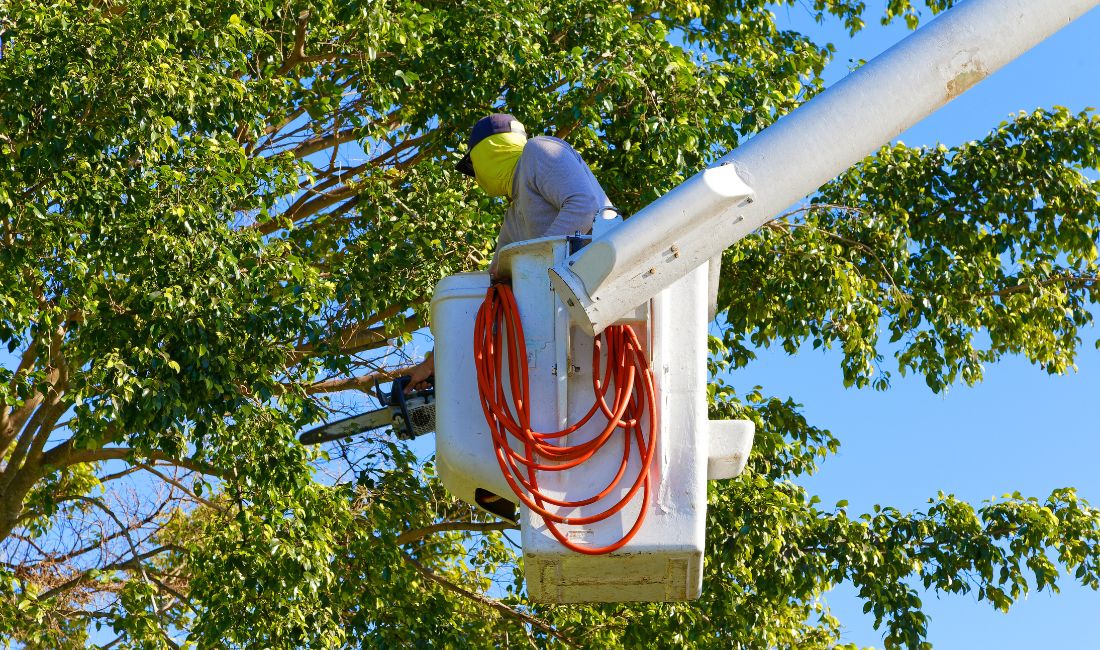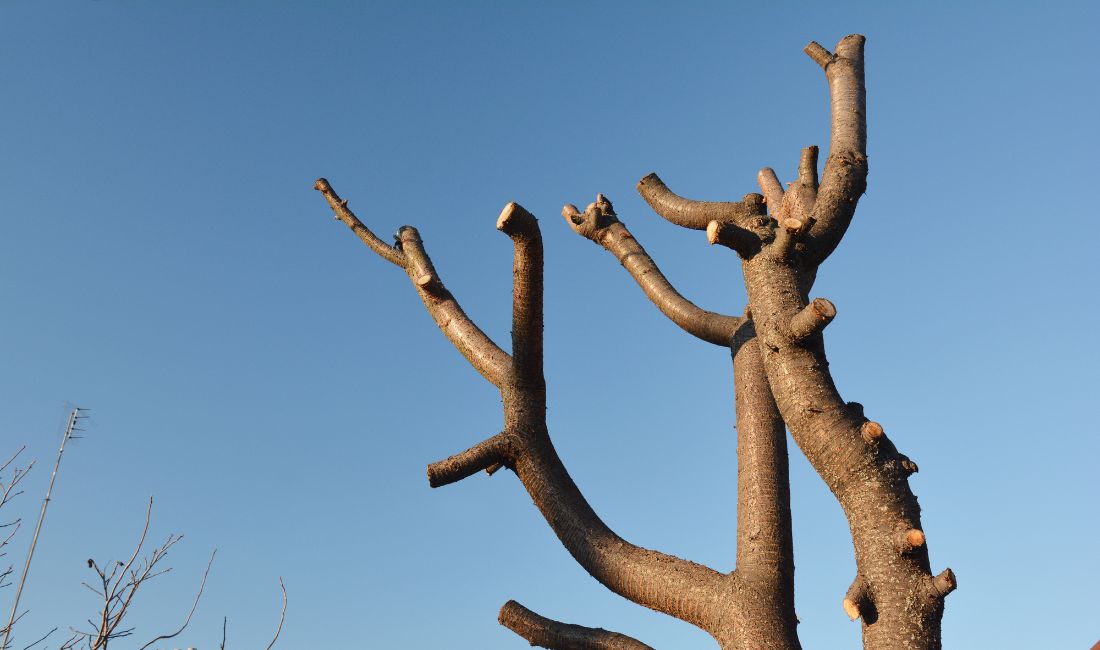Every Palm Beach property owner should understand the different types of pruning that are available for your trees. The right pruning technique protects your home and landscape by creating strong, storm-resistant trees that add value to your property.
But poor pruning – or worse, no pruning – can put your landscape and home at risk. As Certified Arborists who have cared for Palm Beach’s finest properties for over a decade, we’ll explain the five most common types of pruning that help your trees thrive in our unique coastal environment.
Key Takeaways
- Different pruning techniques serve different purposes – from basic maintenance to boosting tree health and improving aesthetics.
- Professional pruning helps strengthen trees, increasing their ability to withstand hurricane-force winds.
- Palm pruning is not the same as regular tree pruning and requires careful attention to ensure it’s done properly.
- Poor pruning practices like tree topping can permanently damage trees and create ongoing problems
Why Proper Pruning Matters to Palm Beach Homeowners
Here in South Florida, your trees are one of your property’s most valuable assets. Not only do they boost curb appeal and home values, but they actually help to minimize damage done to neighborhoods during hurricanes.
But without proper pruning, trees can quickly become a liability, especially during hurricane season. Getting the right type of pruning at the right time makes all the difference in how your trees perform and look year after year.
Here’s what professional tree pruning does for your property:
- Creates stronger, wind-resistant trees that shield your home during hurricane season
- Improves your property’s curb appeal and potentially increases its market value
- Catches tree problems early and helps maintain strong and healthy trees
- Ensures trees maintain a healthy canopy, shading your home and helping reduce cooling costs
- Maintains beautiful views, especially on the waterfront, while keeping trees strong and healthy
- Improves property safety by preventing hazardous branches from falling on your home, cars, or landscaping
- Prevents boundary disputes by maintaining appropriate tree growth
- Creates safer, more enjoyable, and private spaces for your family
- Promotes longer life and stronger growth in your landscape
Pruning is one of the best things you can do to support your trees and help them live longer. Now, let’s explore the five types of pruning and how each one protects and enhances your Palm Beach property.

Types of Pruning Services Available in Palm Beach
Pruning techniques serve various purposes, all aimed at keeping your trees healthy, strong, and visually appealing. Whether you’re enhancing tree structure, improving safety, or boosting curb appeal, each pruning method is designed for a specific goal. Below are the most common pruning services available to help your trees thrive.
1. Crown Cleaning: Remove Dead, Diseased, and Damaged Branches
Crown cleaning is the most basic and important type of pruning for Palm Beach trees, and it’s where we start with every property. Think of it as a checkup for your trees – we remove anything that could cause problems down the road.
What we remove:
- Dead or dying branches
- Broken limbs
- Diseased areas
- Crossing branches
Your Palm Beach property’s biggest trees, like those beautiful live oaks lining your driveway, need regular crown cleaning to stay healthy. Even trees that look fine from the ground can still have hidden dead wood or crossing branches that may break during a storm or compromise tree health. Regular pruning helps prevent these risks and keeps your trees strong and safe.
2. Crown Reduction: Safely Decrease Tree Size
Many people confuse crown reduction with tree topping, but they’re completely different. Crown reduction is a careful technique that makes trees smaller while keeping their natural shape. We trim back main branches to healthy side branches that are at least one-third the size of the cut branch.
Crown reduction pruning is needed when:
- Trees have grown too large for their space
- Branches have grown too close to buildings or power lines
- Wind protection is needed to help trees better handle hurricane-force winds
- Scenic views need to be maintained without harming the tree
This technique works especially well for large Ficus trees and royal poincianas that have outgrown their space. We typically reduce the crown by no more than one-third of its size to prevent unnecessary tree stress.
3. Crown Raising: Create Clearance Below Trees
Crown raising gives you more usable space under your trees by carefully removing lower branches. It’s perfect for driveways, walkways, and areas near buildings where you need more clearance.
Crown raising is necessary in several situations, like when:
- Space needs to be created for vehicles and service vehicles to pass through.
- Pedestrian paths need to be cleared for safety.
- Branches are too close to buildings, potentially causing damage.
- Sunlight is needed to reach the lawn and plants below for healthy growth.
4. Crown Thinning: Improve Light and Air Flow
Crown thinning removes select small branches to reduce weight and let more light and air circulate through the canopy.
Benefits of crown thinning include:
- Improved Airflow: Helps trees withstand strong winds by reducing resistance.
- Increased Light: Allows filtered sunlight to reach your landscape, promoting healthy growth.
- Reduced Weight: Lightens heavy branches, reducing the risk of breakage.
- Enhanced Tree Health: Promotes air circulation, helping prevent fungal growth and diseases.
This type of pruning helps mature trees like live oaks and mahoganies handle storm season better while keeping their natural beauty. We’re always careful not to over-thin, which could harm the tree.
5. Structural Pruning: Build Strong and Stable Trees
Think of structural pruning as engineering for your trees. We focus on creating a strong central trunk with well-spaced branches. While young trees benefit most, this technique can help trees of any age.
When performing structural pruning on trees, we focus on:
- Branch Structure: Fix or remove competing main branches.
- Branch Spacing: Create the right distance between branches.
- Strong Connections: Remove branches with weak attachments.
- Future Growth: Help guide the tree to grow stronger over time.
In Palm Beach, where tropical storms test our trees every year, good structure can mean the difference between a tree that stands strong and one that fails and falls over. That’s why we pay special attention to building strong branch patterns early in a tree’s life.

Why Tree Topping Is Not Pruning
Tree topping is when someone cuts branches back to random points, creating ugly stubs that ruin the tree’s natural shape. Unlike proper pruning that works in tandem with tree biology, topping causes serious damage. Some property owners ask for topping to make trees smaller, not knowing there are better options.
Some problems associated with tree topping include:
- Weak Growth: Topping creates unstable sprouts that are more likely to break.
- Tree Stress: It forces trees to use stored energy to heal large, exposed wounds.
- Decay: Topping opens trees to rot and disease.
- Sun Damage: Removing too many branches exposes sensitive bark to harmful sunlight.
- Poor Health: It strips away essential leaves, which are needed for photosynthesis to produce food for the tree.
- Aesthetic Damage: Topping permanently ruins the tree’s natural shape, which never fully recovers.
- Costly: It leads to ongoing issues, making trees more dangerous and shortening their lifespan.
If you didn’t know, tree topping is illegal in Palm Beach County and many other parts of Florida. Still, some landscapers and homeowners do it anyway. As Certified Arborists, we never top trees. If you’re worried about a tree’s size, ask us about crown reduction instead.

Sabal palms with a healthy, full, rounded canopy.
What About Pruning Palm Trees?
Did you know palms aren’t actually trees? They’re more like giant grasses. Regular trees grow from multiple points and build new wood in layers, but palms grow from a single point at the top and can’t fix damaged areas like trees can. That’s why palms need special care.
Some important considerations for properly pruning and maintaining your palms include:
- Natural Shape: Each type of palm has its own perfect form we should keep. Don’t prune to the point of creating “feather duster” palms.
- Green Fronds: Green fronds photosynthesize and create energy for palms. They should never be removed to create a tidier appearance.
- Dead Fronds: Try not to remove dead fronds until they’re completely brown or barely hanging on.
- Hurricane Cuts: Avoid “hurricane cuts” as they don’t actually help prevent damage during hurricanes. In fact, these cuts do more harm than good.
Caring for Common Palms
Each palm species has its own unique care requirements, so it’s important to understand the best practices for pruning them. Below are some tips for maintaining the health and beauty of the most common palms found in Palm Beach:
- Sabal Palms: Our state tree looks best with a full, round crown – even those yellow lower fronds add to its beauty. The lower fronds also provide a home to bats, which you make not like, but they feast on some of our most-hated insects.
- Royal Palms: Dead fronds need quick removal since they’re heavy and can fall from high up, potentially causing injury or damage to vehicles or landscaping.
- Coconut Palms: In high-traffic areas, focus on removing coconuts and dead fronds to ensure safety.
- Date Palms: Maintain the natural “skirt” of brown fronds unless they obstruct pathways or structures.
Some landscapers cut too many fronds to make palms look “neat,” but this hurts the palm’s health. It’s better to let palms keep their natural shape and only remove fronds that are dead or dangerous.
FAQs About Tree Pruning in Palm Beach
How often should trees be pruned in Palm Beach?
Trees benefit from annual inspections to spot potential problems early. Most mature trees need pruning every 2-5 years, the more frequent crown cleaning is an option to maintain appearances. The schedule depends on the type of tree, where it grows, and how fast it grows.
Can pruning save a storm-damaged tree?
Often yes, but you need to act fast. Have a Certified Arborist check storm damage right away to see if pruning can help your tree recover. The sooner we can fix damaged areas, the better chance your tree has to heal and stay strong.
Will pruning make my tree grow faster or slower?
Pruning helps direct growth in a good way. While your tree might grow a bit slower right after pruning, it ends up growing stronger and in better directions for your landscape.
What’s the best season for pruning in South Florida?
Winter is best for major pruning because trees are less stressed and it gets them ready for hurricane season. But if you have dead or dangerous branches, those should come off any time of year.
Expert Tree Care for Your Palm Beach Property
Trees in South Florida need special care. They must be strong enough to handle hurricane winds while looking beautiful enough to match aesthetic of Palm Beach’s luxury neighborhoods. Getting the right type of pruning by local, certified professionals makes all the difference in how your trees look and perform.
Our ISA Certified Arborists have the expertise to ensure your Palm Beach trees thrive. We follow the latest best practices and always treat your trees with the care they deserve.
Ready to protect your property’s trees? Request an estimate online or call us at 561-308-7604.
CALL US TODAY At 561-308-7604
Estate landscape Services
For Fine Properties in Palm Beach
With Coastal Gardens, you can rest easy knowing that your property is taken care of by a dedicated team of estate landscape professionals who truly care about creating and maintaining a dazzling outdoor space you can be proud of.
